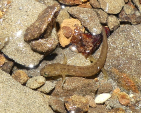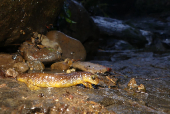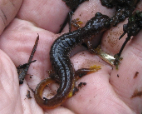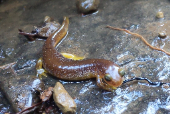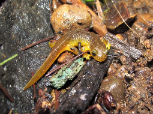Columbia Torrent Salamander (Rhyacotriton kezeri)
Description: The Columbia torrent salamander is a small, aquatic, stream-adapted salamander (rarely more than 2.2 inches snout to vent length). The head is small with a short, rounded snout The body is relatively long with short limbs and a short tail. Coloration is beige-brown above and yellow to orange yellow below. White speckling on the body tends to be more concentrated along the sides. Black speckling also exists, but is very reduced to fine flecking, also mostly along the sides. In general, this species lacks the dark dorsal (topside) and ventral (underside) spotting or blotching that is prominent in the Cascades torrent salamander.
Columbia torrent salamanders have large prominent eyes. The large size of the eyes (eye diameter approximately equal to snout length), relatively short, rounded snout and generally prominent yellow component to the belly color are features that help distinguish torrent salamanders from other Washington salamanders.
Adult male torrent salamanders can be distinguished from all other salamanders by the presence of prominent squared vent lobes, a trait unique to the family and the genus.
The color pattern and morphology of torrent salamander species are similar and variable; therefore, torrent salamander species are best identified by collection locality and how that relates to the documented ranges of each species.
Habitat: This species occurs in coastal coniferous forests in and along permanent, cold streams and spring seeps containing small, water-washed or moss-covered rocks and rock rubble. Individuals tend to prefer sites in seeps and small, trickling tributary streams where the movement of water is relatively slow. Contact with water or a wet, saturated substrate is habitually maintained by this species, thus making it very sensitive to desiccation (Green et al. 2014, NatureServe 2020). This species is largely restricted to streams, and only rarely do individuals venture as far as 50 m from water (Good and Wake 1992). This species is commonly associated with mature forests but is also found in young forests where suitable microclimatic and microhabitat conditions are maintained. This species is a larval developer, with larvae often occurring under stones in shaded reaches of streams, where shading can be provided by over or understory vegetation, or by wood cover within the stream
Range: This species is restricted to coastal and near-coastal regions of the Coast Ranges of the western USA, stretching from the vicinity of the Chehalis River in Grays Harbor County, Washington, south to the zone of contact with Rhyacotriton variegatus along the Little Nestucca River and the Grande Ronde Valley in Polk, Tillamook, and Yamhill Counties in northwest Oregon. It occurs at elevations from near sea level to approximately 1,000 m asl.
Found in these States:
OR |
WA
Diet: Metamorphosed forms eat a variety of aquatic and semiaquatic invertebrates, while larval forms eat aquatic invertebrates.
Reproduction: The salamanders are active year round, but the reproductive ecology is not well known. The mating season is probably prolonged similar to other torrent salamander species. Only five nests have been found, presumably because the eggs are laid in inaccessible recesses in head-water streams and seeps.
Status: Listed as Near Threatened because its extent of occurrence (EOO) is 22,824 km2, it likely occurs in 10 or fewer threat-defined locations, and there is continuing decline in the extent and quality of its habitat, thus making the species close to qualifying for Vulnerable.
»» Kingdom: Animalia - Animals
»» Phylum: Chordata - Chordates
»» Subphylum: Vertebrata - Vertebrates
»» Class: Amphibia - (Amphibians)
»» Order: Caudata - Salamanders
»» Family: Rhyacotritonidae - Torrent Salamanders
»» Genus: Rhyacotriton
»» Species: Rhyacotriton kezeri - Columbia Torrent Salamander
This article uses material from the Wikipedia article "Columbia Torrent Salamander", which is released under the Creative Commons Attribution-Share-Alike License 3.0. Content may have been omitted from the original, but no content has been changed or extended.
|


